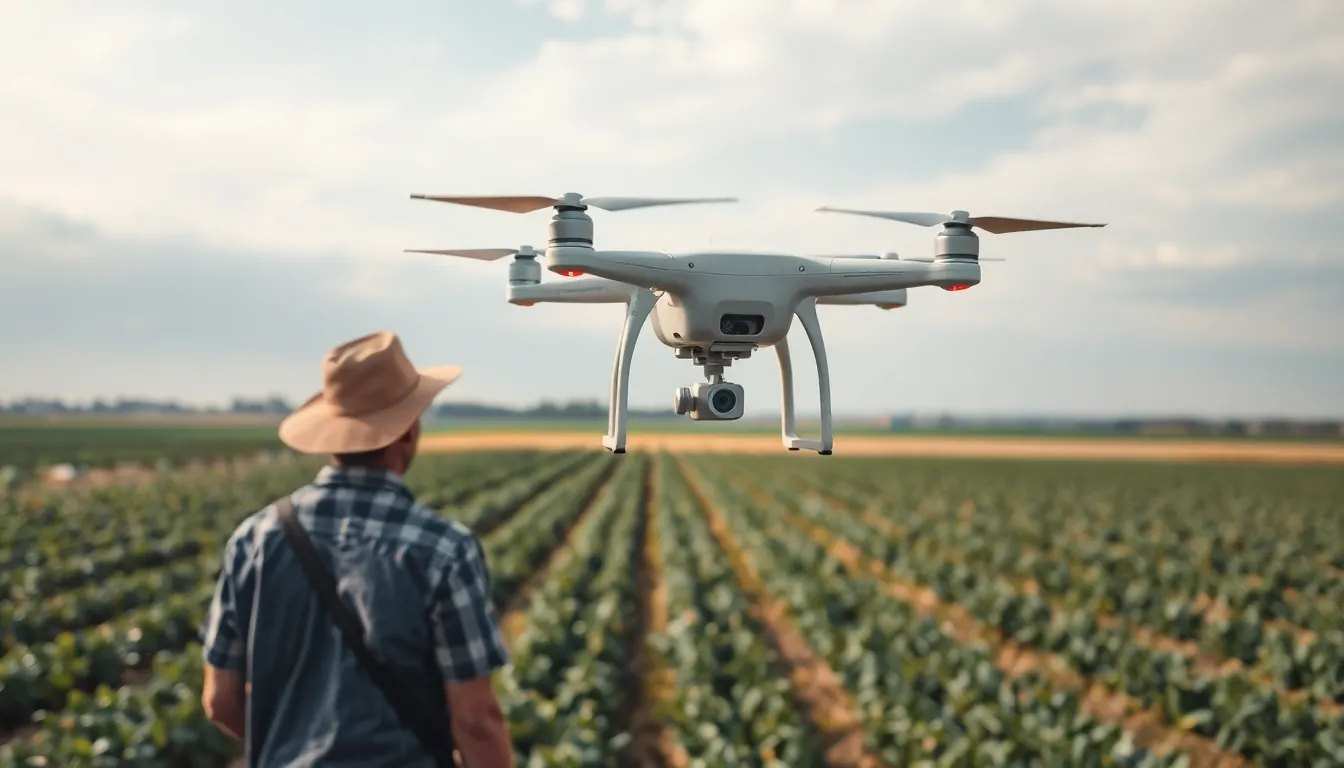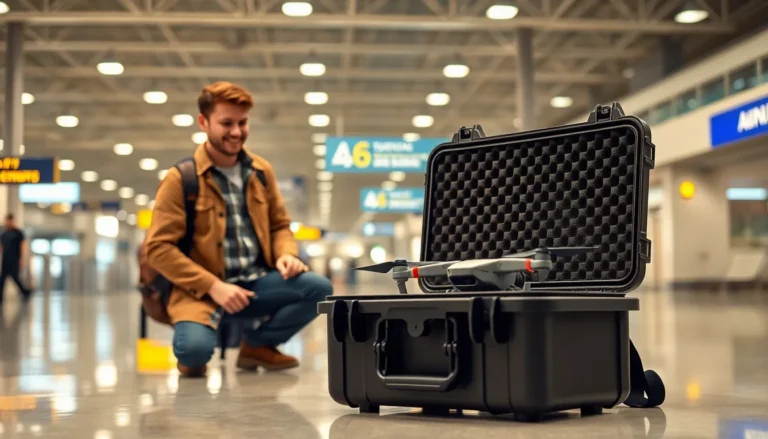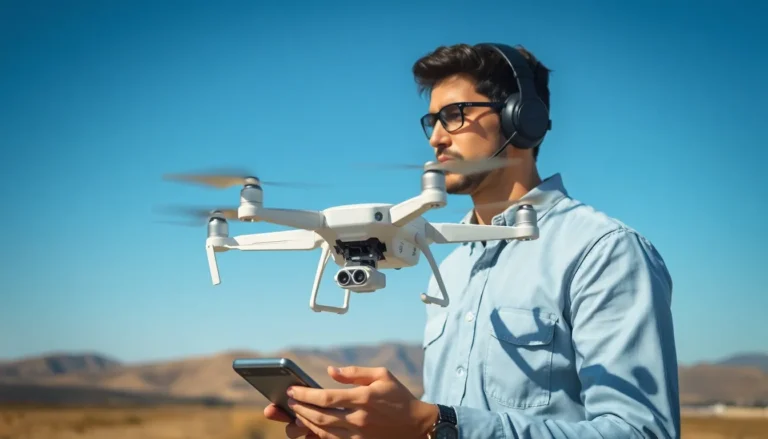In a world where delivery drones are as common as pizza boxes, commercial drones are taking to the skies like kids on a sugar rush. These flying marvels aren’t just for aerial selfies or delivering tacos; they’re revolutionizing industries from agriculture to construction. Imagine a farmer monitoring crops from above while sipping coffee in his living room. Sounds like a sci-fi movie, right?
Table of Contents
ToggleOverview Of Commercial Drones
Commercial drones play a crucial role across numerous industries, reshaping operations and enhancing efficiency. They serve agricultural purposes, enabling precise crop monitoring and data collection. In construction, drones facilitate site surveys and progress tracking, providing vital insights for project management.
Entertainment is another area benefiting from commercial drones. Filmmakers and event organizers use them to capture unique aerial perspectives, transforming visual storytelling. Logistics sectors adopt drones for last-mile deliveries, demonstrating their potential to streamline shipping processes.
Environmental monitoring relies on drones to gather data on wildlife, vegetation, and ecosystems. Organizations utilize these aerial vehicles for mapping, surveying, and assessing environmental impacts. Safety inspections in infrastructure, such as bridges and power lines, are conducted with drones, reducing risks associated with manual inspections.
Regulatory developments also influence the commercial drone landscape. The Federal Aviation Administration (FAA) established guidelines to ensure safe drone operation in national airspace. Compliance with these regulations fosters industry growth and innovation.
Data analytics enhances the benefits of commercial drones. Collected data assists businesses in making informed decisions, optimizing resource allocation, and increasing overall productivity. Various industries now recognize the value drones bring to operational processes, and their implementation continues to rise as technology advances.
Commercial drones represent a significant evolution in how industries function, offering new solutions for age-old challenges. As sectors embrace drone technology, the future promises further integration of these unmanned aerial vehicles in daily operations.
Types Of Commercial Drones

Commercial drones come in various types, each designed to meet specific operational needs across different industries. Understanding these varieties helps businesses select the right drone for their applications.
Fixed-Wing Drones
Fixed-wing drones excel in covering large areas without the need for extensive battery power. They possess wings, allowing for efficient aerodynamics and longer flight times compared to other types. Applications often include agricultural monitoring, surveying, and mapping. These drones can carry heavier payloads, making them suitable for delivering high-resolution imaging and multiple sensors. For instance, farmers use fixed-wing drones to track crop health, gathering valuable data swiftly and accurately.
Multi-Rotor Drones
Multi-rotor drones utilize multiple rotors for vertical takeoff and landing capabilities, allowing greater maneuverability in confined spaces. Their design makes them ideal for real-time data collection, inspections, and aerial photography. Various industries rely on these drones for tasks like surveying construction sites, conducting infrastructure inspections, and capturing high-quality video footage. Additionally, they can often be equipped with specialized cameras and sensors, enhancing their versatility. Event planners frequently adopt multi-rotor drones to capture dynamic aerial views during gatherings.
Applications Of Commercial Drones
Commercial drones now play crucial roles across various industries, showcasing their versatility and effectiveness.
Agriculture
In agriculture, drones monitor crops with precision. They gather data on plant health, soil conditions, and water usage, enabling farmers to make informed decisions. Crop mapping allows for targeted treatments, reducing resource waste. Farmers benefit significantly from the ability to assess large fields quickly, thus enhancing productivity. Additionally, drones assist in pest and disease monitoring, ensuring timely interventions. Their use leads to improved yields and reduced operational costs, proving invaluable for modern farming practices.
Construction
Construction projects utilize drones for comprehensive site surveys. These unmanned aerial vehicles capture high-resolution images and generate 3D models, streamlining project planning. Workers receive real-time data regarding site progress, helping to track timelines and budgets. Inspections of hard-to-reach areas reduce safety risks for personnel. Regular aerial assessments also promote efficient decision-making and resource allocation. By providing accurate measurements, drones facilitate effective project management throughout various construction phases.
Delivery Services
Delivery services are transforming with the use of commercial drones. Companies implement these drones to transport packages quickly and efficiently to customers’ doorsteps. Last-mile delivery becomes faster, catering especially to urban areas with heavy traffic. Drones address challenges such as rising shipping costs and increased demand for prompt service. Additionally, various industries experiment with drone technology for medical supplies and food deliveries, demonstrating its broad potential. The shift toward drone-assisted logistics reflects ongoing innovation across the delivery sector.
Photography And Filmmaking
Photography and filmmaking benefit from the aerial perspectives that drones offer. Unique vantage points enhance creativity and storytelling in visual media. Filmmakers capture stunning landscapes and dynamic scenes more easily than traditional methods allow. Event organizers use drones for real-time coverage, providing breathtaking views and innovative content. Drones enable efficient shooting schedules, cutting time spent on set. Their ability to blend technology with artistry opens new avenues for professional and amateur creators alike.
Benefits Of Using Commercial Drones
Commercial drones provide numerous advantages across various industries. Enhanced efficiency stems from their ability to perform repetitive tasks quickly, helping organizations save time and reduce labor costs. Accurate data collection allows for in-depth analysis, leading to better decision-making. For instance, drones equipped with sensors capture detailed information about crop health and environmental conditions, empowering farmers to manage resources effectively.
Improved safety remains a critical benefit. Drones facilitate inspections in hazardous environments, such as construction sites or power lines, minimizing risks to human workers. Cost savings also emerge through reduced manpower and lower operational expenses. Companies can allocate resources elsewhere, maximizing overall productivity.
Research shows that businesses employing drones experience a significant boost in operational efficiency. For example, logistics firms leverage drone technology for faster deliveries, which meets growing consumer demand for prompt service. Supply chain optimization occurs as drones navigate complex routes without the limitations of traditional vehicles.
Flexibility presents another key advantage. Various industries adapt drones for multiple applications, from agricultural monitoring to cinematography. These unmanned aerial vehicles can adjust to diverse environments, overcoming terrain challenges seamlessly.
Environmental sustainability receives a boost as drones minimize transportation needs, resulting in reduced carbon emissions. Significant monitoring capabilities contribute to wildlife protection and ecosystem preservation, proving beneficial to conservation efforts.
Finally, continuous advancements in drone technology foster innovation. With each improvement in flight autonomy and imaging quality, the potential applications expand, leading to new opportunities and efficiencies. Commercial drones redefine operational standards, enhancing productivity while lowering risk across various sectors.
Challenges And Limitations
Commercial drones face several challenges that hinder their widespread adoption. Regulatory hurdles stand out as a significant barrier, with the Federal Aviation Administration establishing stringent guidelines for drone operations. Compliance with these regulations often complicates deployment for businesses, requiring time-consuming approvals and pilot certifications.
Technical limitations represent another concern. Battery life significantly impacts drone flight duration, often restricting operational time to 20 to 30 minutes. This lack of endurance can hinder tasks that require extensive coverage or continuous monitoring. Additionally, varying weather conditions pose challenges for safe drone operations. Rain, snow, or high winds can disrupt flights and impact data collection quality.
Privacy concerns also arise with the growing use of commercial drones. Public apprehension about surveillance and data collection could lead to pushback against their deployment. Addressing these issues requires transparent practices and robust data protection measures.
Safety risks contribute to limitations as well. Malfunctions can result in accidents, posing hazards to people and property. Implementing fail-safe mechanisms becomes essential to mitigate these risks and ensure safe operations.
Market competition intensifies as more companies enter the commercial drone space. Innovators frequently seek to outpace each other, which can lead to rapid changes in technology and practices. Keeping up with advancements poses challenges for businesses attempting to integrate drones into their existing operations.
Interoperability issues with existing technology can complicate implementation. Many industries may find it difficult to integrate drones with current systems, causing inefficiencies. Industry-standard frameworks can help streamline integration processes and enhance operational efficiency.
Overall, addressing these challenges and limitations remains crucial for maximizing the potential benefits of commercial drones across various industries.
Future Trends In Commercial Drones
Advancements in commercial drone technology secure a prominent position in various industries. The integration of artificial intelligence enhances drone capabilities, enabling autonomous navigation and improved data analysis. Automated flight paths improve efficiency and reduce the need for constant human oversight.
Regulatory changes continually shape the landscape for commercial drones. The Federal Aviation Administration (FAA) is expected to streamline regulations, facilitating broader usage across multiple sectors. Updates in airspace management allow drones to operate alongside manned aircraft safely.
Data analytics will play a critical role in optimizing drone operations. Businesses will increasingly leverage insights from drone-gathered data for informed decision-making. Predictive analytics can anticipate crop conditions in agriculture or monitor infrastructure health in construction.
Sustainability trends are also influencing the future of commercial drones. Companies are exploring electric drones to minimize environmental impact. The focus on reducing carbon footprints aligns with global efforts toward sustainability.
In logistics, drone delivery systems are set to evolve. Innovations like drone hubs will enhance the efficiency of last-mile delivery services. Partnerships between retail companies and drone manufacturers promise faster and more reliable delivery options.
Moreover, consumer acceptance of drones is gradually increasing. Public awareness campaigns highlighting safety measures and benefits foster positive perceptions. Communities are recognizing how drones can assist with public safety and emergency response scenarios.
Emerging applications in sectors such as healthcare and agriculture indicate potential for unprecedented growth. Drones will deliver medical supplies to remote areas, improving access to essential resources. Crop monitoring technologies will continue to evolve, helping farmers maximize yields and reduce waste.
Investment in drone technology is expected to surge. Entrepreneurs and established companies alike are directing capital toward research and development. Such investments are likely to drive innovations that expand the frontiers of commercial drone applications.
Commercial drones are revolutionizing multiple industries by enhancing efficiency and transforming operational processes. Their ability to gather data and perform tasks quickly is making them indispensable in agriculture, construction, and logistics. As technology advances and regulations evolve, the potential for drones to integrate seamlessly into everyday operations grows.
The benefits extend beyond mere cost savings and improved safety. Drones are paving the way for innovative applications that promote sustainability and environmental monitoring. With increasing investment and technological advancements on the horizon, the future of commercial drones looks promising. As businesses continue to embrace this technology, the impact on productivity and operational efficiency will only deepen, making drones a vital component of modern industry.





